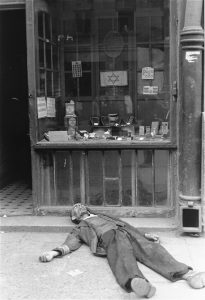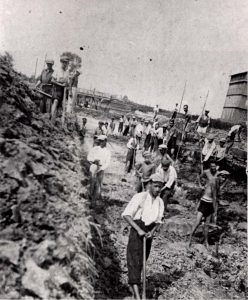Part 3: Creation of Ghettos and Expansion of Camps (1939-1942)

A man lies dead in front of a shop in the Warsaw ghetto in Nazi-occupied Poland, circa June-August 1941. Photo credit: USHMM #20614
In September 1939, after the Nazis started World War II with the invasion of Poland, the Nazi system of incarceration became increasingly deadly. The Germans began by targeting Polish politicians, military officials, Catholic clergy, and intellectuals. Over the next few years, particularly after the Nazis invaded the Soviet Union in 1941, the Third Reich brutalized millions of Slavic and Jewish civilians as they sought to colonize Eastern Europe.

Jewish prisoners in the Wlodawa labor camp near Lublin in Nazi-occupied Poland, date unknown. Photo credit: Yad Vashem #69DO5
Soon, the Nazis began murdering their enemies en masse. Over two million people, the majority of whom were Jews as well as Roma and Sinti, were killed by Nazi mobile killing squads (Einsatzgruppen) and by Nazi-sympathetic militias. The Nazis also relied heavily on their concentration camp system to subjugate conquered populations. Existing camps were expanded while several new ones were established, including Mauthausen (Austria), Natzweiler-Struthof (France), and Stutthof (Poland). Large numbers of prisoners came from Germany, Poland, France, the Netherlands, the Czech lands, and other Nazi-controlled areas, including Yugoslavia. Some were taken as hostages and threatened with execution if their communities defied the Nazis. All told, the number of camp inmates tripled between 1939 and 1942.
During this time, Nazi Germany controlled the greater part of the European continent. Across German-occupied Europe, Jews lost their jobs and frequently had to wear distinctive yellow badges or armbands with the Star of David identifying them as Jewish. Millions of Jewish people were also confined into 1,144 enclosed neighborhoods called ghettos in Nazi-occupied Eastern Europe. Two of the largest ghettos were in the Polish cities of Warsaw and Łódź, where approximately 400,000 and 200,000 Jewish people were concentrated, respectively. The Germans did not supply enough food or medicine to the ghettos, causing tens of thousands to die from hunger, thirst, and rampant disease.
Each year, more people were deported from ghettos to various kinds of concentration camps, and the scale of Nazi violence continued to grow in intensity. More and more prisoners died in the camps from starvation, being worked to death, or by execution. One of the largest groups to fall victim to German brutality were Soviet prisoners of war (POWs), of whom an estimated 3.5 million died in Nazi-controlled concentration camps.
